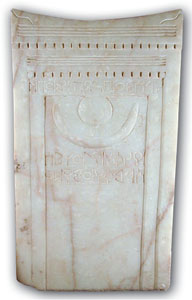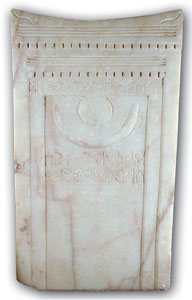
Sacrificial altars plentiful among National Museum antiquities [Archives:2006/1005/Last Page]
December 7 2006
 |
For the Yemen Times
Sacrificial altars associated with Yemen's ancient religion, which worshipped the sun, moon and the goddess Venus are abundant at the National Museum. The Republican Guard recently discovered seven important antiquities, including several altar tables.
Such tables were used during religious rituals in ancient Yemeni temples to slaughter sacrifices, as well as offer water and milk in an attempt to get closer to a god or goddess.
“In Yemen's ancient religion, sacrifices were highly regarded in the souls of worshippers and topped the types of sacrifices ancient Yemenis presented to their gods and goddesses. Many inscriptions bear the names and shapes of these gods and goddesses,'' Dr. Mounir Abduljalil, and archaeological specialist explains.
Rituals associated with sacrifices of slaughter were important in the lives of ancient Yemenis until the pre-Islamic era because worshippers could get closer to their gods and goddesses through the altar. Abduljalil points out that such marble and plaster altars were rectangular.
One museum possession is referred to as an example of ancient Yemeni life. It's a rectangle made of plaster that's 5 cm. deep and its front is shaped like a bull's head. The table, which was dedicated to the Moon Goddess, has fascinating inscriptions on the back. Executioners attending and performing religious rituals in ancient Yemeni temples used the table to slaughter sacrifices.
The recently discovered antiquities are rectangular and square-shaped altars with smooth bases. One such table with various inscriptions on the back was used for slaughtering sacrifices. On one side is a bull's head, which several researchers believe is a symbol for the Moon Goddess in ancient Yemeni religion because the bull's horns are crescent-shaped, which is one of the moon's phases. Its sculptors took the bull's strength as a symbol of fertility.
According to Abduljalil, such antiquities were found in many Egyptian civilizations, particularly as the bull is depicted in numerous paintings and statues. Similarly, ancient Iraqi civilization featured a group of effigies for the bull, which symbolized the Goddess of Fertility.
Due to the bull's importance as a significant symbol in ancient Yemeni religion, Yemeni houses contained many bronze antiquities, which now are abundant in the National Museum.
These antiquities feature inscriptions on four sides, while atop one side is a 19 cm.-long groove shaped like a bull's head. The altars have smooth bases, broader at the bottom and narrower at the top, and usually were lodged deep in the ground to fix the tables.
——
[archive-e:1005-v:14-y:2006-d:2006-12-07-p:lastpage]


